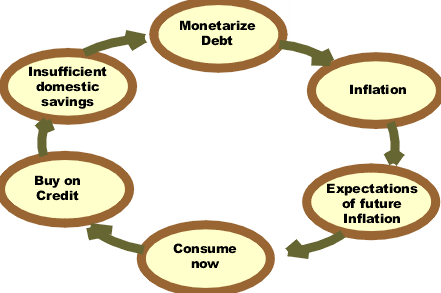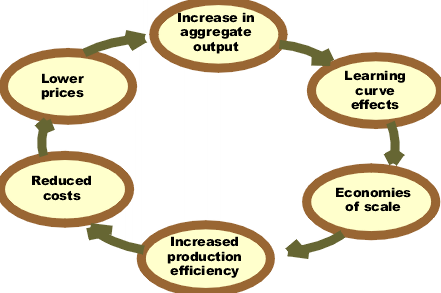Virtuous circle and vicious circle
|
|
In many parts of economics there is an assumption that a complex system of determinants will tend to lead to a state of equilibrium. When this tendency is absent we use terms like virtuous circle and vicious circle (or virtuous cycle and vicious cycle) to describe these unstable pattern of events. Both circles are complexes of events with no tendency towards equilibrium (at least in the short run). Both systems of events have feedback loops in which each iteration of the cycle reinforces the first (positive feedback). The difference between the two is that a virtuous cycle has favorable results and a vicious cycle has deleterious results. These cycles will continue in the direction of their momentum until an exogenous factor intervenes and stops the cycle. The prefix “hyper” is sometimes used to describe these cycles. The most well known vicious circle is hyperinflation.
| Contents |
Example of a vicious circle in macroeconomics
Hyperinflation is where a spiral of inflation causes still more inflation in the future. The initial exogenous event might be a sudden large increase in international interest rates or a massive increase in government debt due to the funding of a mega-project. Whatever the cause, the government could pay down some of its debt by printing more money (called monetarizing the debt). This increase in the money supply could increase the level of inflation. In an inflationary environment, people tend to spend their money quickly because they expect its value to decrease further in the future. They convert their financial assets into physical assets while their money still has some purchasing power. Often they will purchase on credit. Because of this, the level of savings in the country is very low and the government could have problems refinancing its debt. It’s solution could be to print still more money starting another iteration of the vicious cycle.
Example of a virtuous circle in macroeconomics
Economic growth can be seen as a virtuous circle. It might start with an exogenous factor like technological innovation. As people get familiar with the new technology, there could be learning curve effects and economies of scale. This could lead to reduced costs and improved production efficiencies. In a competitive market structure, this will likely result in lower average prices. As prices decrease, consumption could increase and aggregate output also. Increased levels of output leads to more learning and scale effects and a new cycle starts.
Example of a virtuous circle in management
An investment in your employees’ ability to provide superior service to customers can be seen as a virtuous circle. Effort spent in selecting and training employees and creating a corporate culture in which they are empowered can lead to increased employee satisfaction and employee competence. This will likely result in superior service delivery and customer satisfaction. This in turn will create customer loyalty, improved sales levels, and higher profit margins. Some of these profits can be reinvested in employee development thereby initiating another iteration of a virtuous cycle.
Example of a vicious circle in management
A harvesting strategy can be an example of a vicious circle. Rather than reinvesting in employee development, new product development, and marketing research, management could decide to harvest their investment by reducing costs then increasing dividends or increasing executive compensation. The consequence of this could be reduced employee wages, minimal training, an outdated product line, and a failure to understand the needs of the customer. This will likely result in employee dissatisfaction, employee incompetence, and high employee turnover. This could cause poor service delivery, customer dissatisfaction, high customer turnover, and loss of market share. Reduced sales and lower profit margins may require a further reduction in investment thereby initiating another iteration of the vicious cycle.
See Also:
Finding related topics
- list of economics topics
- list of finance topics
- list of accounting topics
- list of management topics
- list of human resource management topics
- list of marketing topics
- list of information technology management topics
- list of international trade topics
- list of production topics
- list of business law topics
- list of business ethics, political economy, and philosophy of business topics
- list of business theorists
- list of economists
- list of corporate leaders
- list of companies
External sources
- Schlesinger, L. and Heskett, J. (1991) Breaking the cycle of failure in services, Sloan Management Review, vol. 31, spring 1991, pp.17 - 28.
- http://william-king.www.drexel.edu/top/prin/txt/gro/gro21b.html - An introduction to 20th century virtuous circle theory.
External sources : Virtue in economics
- Rational Choice with Passion:Virtue in a Model of Rational Addiction (http://216.239.37.104/search?q=cache:TxgNA2SGlWQJ:www.gordon.edu/ace/pdf/Yuengert_Choice.pdf+Virtue+%22economics%22&hl=en&ie=UTF-8) - In this link the author uses Aristotelian virtue as a mediator between passion and reason in the construction of utility/consumption functions in an esoteric part of consumer behaviour theory related to decision making in addictive situations.
- China: A Stabilizing or Deflationary Influence in East Asia? The Problem of Conflicted Virtue (http://www-econ.stanford.edu/faculty/workp/swp03007.html) - In this link the author is using virtue in the sense of a positive outcome (balance of payments surplus) that conflicts with long term regional growth and stability.



